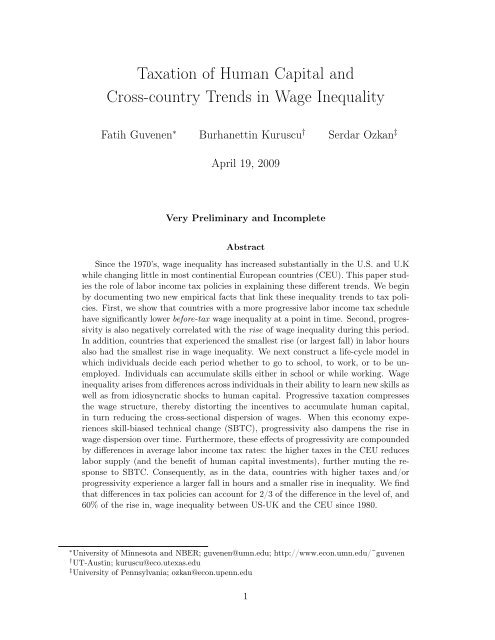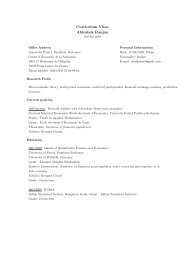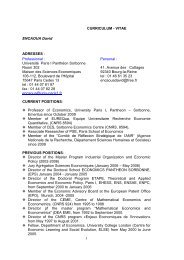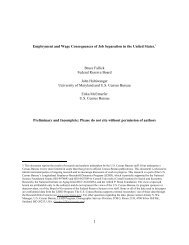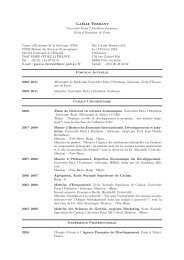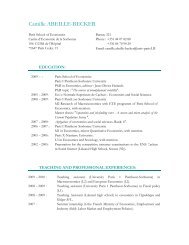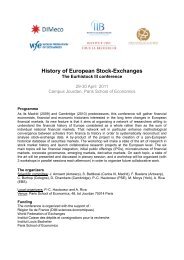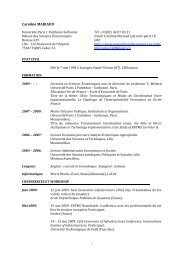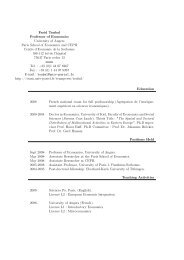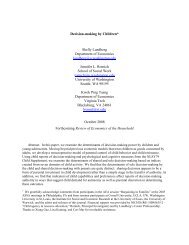info document - Paris School of Economics
info document - Paris School of Economics
info document - Paris School of Economics
You also want an ePaper? Increase the reach of your titles
YUMPU automatically turns print PDFs into web optimized ePapers that Google loves.
Table 1: Log Wage Differential Between the 90th and 10th Percentiles1978-1982 2001-2005 ChangeDenmark 0.76 0.97 0.20Finland 0.91 0.89 -0.01France 1.18 1.08 -0.10Germany 1.06 1.15 0.09Netherlands 0.94 1.06 0.12Sweden 0.71 0.83 0.12CEU 0.93 1.00 0.07UK 1.09 1.27 0.18US 1.33 1.56 0.23US-UK 1.21 1.42 0.21wages early on in return for higher wages later in life. Thus, a key source <strong>of</strong> wage inequalityin this model is the systematic fanning out <strong>of</strong> the wage pr<strong>of</strong>iles. Recent evidence from paneldata on individual wages provide support for individual-specific growth rates in wages; see,for example, Baker (1997), Guvenen [2007, 2009], and Huggett et al. [2007].The second element in the model, and the main driving force behind the changes in wagesduring this period, is skill-biased technical change (SBTC), which is modeled as a rise inthe productivity <strong>of</strong> human capital relative to raw labor. Because <strong>of</strong> the two-factor structuredescribed above, the marginal cost <strong>of</strong> human capital investment (i.e., forgone earnings) isproportional to the prices <strong>of</strong> both human capital and raw labor, whereas the marginal benefit<strong>of</strong> investment is proportional only to the price <strong>of</strong> human capital. Therefore, SBTC increasesthe benefit more than the cost, resulting in a rise in human capital investment. Furthermore,the strength <strong>of</strong> this investment response increases with the ability level, implying that thosewith high ability increase their investments more than others, accepting even lower wagesearly in life in return for even higher wages later in life. Therefore, cross-sectional wageinequality rises due to the further fanning out <strong>of</strong> wage pr<strong>of</strong>iles after SBTC.The model described here provides a central role for policies that compress the wagestructure—such as progressive income taxes—because they hamper the incentives to accumulatehuman capital. This is because progressive income taxes reduce (after-tax) wagesat the higher end <strong>of</strong> the wage distribution while boosting at the lower end. As a result,they reduce the marginal benefit <strong>of</strong> investment (the higher wages in the future) relative tothe cost <strong>of</strong> investment (the current forgone earnings), and hinder investment. 1 Therefore,1 A similar effect is caused by minimum wage laws, which impose an upper bound on the amount <strong>of</strong>on-the-job human capital investment, by effectively preventing firms from creating jobs that <strong>of</strong>fer low initialwages (below the legal minimum) but higher training opportunities. We also model minimum wage laws in3
Table 2: Decomposing the Change in Log 90-10 Wage DifferentialTotal Change Percentage due toin Log 90-10 Log 90-50 Log 50-10CEU 0.07 91% 9%US-UK 0.21 76% 24%Difference 0.14 68% 32%individuals in an economy with a compressed wage structure will not increase their investmentsas much as in an economy with a less progressive tax schedule. As a result, the modelpredicts that countries with a more redistributive tax system will not experience a largeincrease in inequality in response to SBTC, but will also not be able to accumulate therequisite human capital, and therefore experience the growth surge that happens severaldecades after the onset <strong>of</strong> SBTC.We assume all countries to have the same innate ability distribution but allow eachcountry to differ in the observable dimensions <strong>of</strong> their labor market structure, such as inlabor (and consumption) tax schedules, and in unemployment insurance and retirementbenefits system, among others (although it turns out that the tax system is the dominantfactor in the quantitative results below). These policy differences explain about 2/3 <strong>of</strong> theobserved gap in wage inequality between US-UK and CEU at the beginning <strong>of</strong> 21st century.Second, when we choose the degree <strong>of</strong> skill-biased technical change between 1980 to 2000to match the rise in wage inequality in the US during this period, the model explains about60% <strong>of</strong> the observed gap in the rise in wage inequality between US-UK and CEU duringthis time period. Finally, the smaller inequality in the CEU comes at the expense <strong>of</strong> loweremployment and lower GDP per capita since workers do not accumulate as much humancapital as in the US.In a recent paper, Guvenen and Kuruscu [2007] has studied a stylized version <strong>of</strong> thepresent framework—one that abstracts from idiosyncratic shocks as well as from all theinstitutional details studied here—and applied it to U.S. data. It concluded that even thatstark version <strong>of</strong> the model provides a fairly successful account <strong>of</strong> several trends observed inthe U.S. data since the 1970’s, including the rise in overall wage inequality; the initial fall inthe college premium in 1970’s and the subsequent strong increase in the next two decades;the rise in within-group wage inequality; the stagnation in aggregate productivity growth,and the small rise in consumption inequality despite the large rise in wage inequality. Inthis paper, we build on this research by explicitly modeling labor market institutions andallowing for idiosyncratic shocks to provide a detailed quantitative assessment <strong>of</strong> the rolethe paper.4
<strong>of</strong> policies for wage inequality.The paper is organized as follows. The next section starts with a stylized model toexplain the various channels through which the tax structure affects human capital investmentand, consequently, inequality. It then discusses how the country-specific tax schedulesare estimated and uses the estimates to <strong>document</strong> some empirical links between taxes andinequality. Section 3 presents the full model and the calibration is carried out in Section 4.Section 5 discusses the quantitative implications. Section 6 concludes.2 US-UK versus CEU: Differences in Empirical TrendsIn this section, we <strong>document</strong> two new empirical relations between wage inequality and theprogressivity <strong>of</strong> the tax policy. Although what is meant by progressivity is well-understoodas a qualitative concept, 2 the precise empirical measure <strong>of</strong> progressivity we focus on issuggested by the model studied here. To this end, we begin with a stylized version <strong>of</strong> themore general model studied in Section 3 that illustrates the key mechanisms at work andwill allow us to define different measures <strong>of</strong> progressivity subsequently used in <strong>document</strong>ingthe empirical facts. We then discuss how the tax schedules are derived for each country andpresent the empirical findings in section 2.3.2.1 Intuition in A Stylized ModelConsider an individual who derives utility from consumption and leisure and has accessto borrowing and saving at a constant interest rate, r. Each period individuals have oneunit <strong>of</strong> time endowment that they allocate between leisure and work (n ∈ [0, 1]). Whileworking, individuals can accumulate new human capital, Q, according to a Ben-Porath styletechnology. Specifically, Q = A j (hin) α where h denotes the individuals’ current humancapital stock, i denotes the fraction <strong>of</strong> working time (n) spent learning new skills, and A jis the learning ability <strong>of</strong> individual type j. We assume that skills are general and labormarkets are competitive. As a result, the cost <strong>of</strong> human capital investment is completelyborne by workers, and firms adjust the hourly wage rate downward by the fraction <strong>of</strong> timeinvested on the job (equation (2)). Finally, labor earnings are taxed at a rate given by theaverage tax function ¯τ n (y) and the corresponding marginal tax rate function is denoted by2 The American Heritage Dictionary defines progressive taxes as “..increasing in rate as the taxableamount increases.” Similarly, the Britannica Concise Encyclopedia defines it as “tax levied at a rate thatincreases as the quantity subject to taxation increases.”5
τ(y). Putting these pieces together, the problem <strong>of</strong> a type j individual can be written as:maxc s,a s+1 ,i ss.tS∑β s−1 u(c s , n s )s=1c s + a s+1 = (1 − ¯τ n (y s ))y s + (1 + r)a sh s+1 = h s + A j (h s i s n s ) α (1)y s = P H h s (1 − i s )n s (2)Using the fact that Q j s = A (h s i s n s ) α , the “cost <strong>of</strong> investment” (ie., h s i s n s ) can be writtenas: C j (Q j s) = (Q s /A j ) (1/α) , which will play a key role in the optimality conditions below.Now, it is useful to distinguish between two cases.Inelastic Labor Supply. First, suppose that labor supply is inelastic, in which casen s = 1. The optimality condition for human capital investment is (assuming an interiorsolution):(1 − τ(y s )) C ′ j(Q j s) ={β(1 − τ(y s+1 )) + β 2 (1 − τ(y s+2 )) + ... + β S−s (1 − τ(y S ))}. (3)The left hand side is the marginal cost <strong>of</strong> investment, whereas the right hand side is themarginal benefit, which is given by the present discounted value <strong>of</strong> net wages in all futuredates earned by the extra unit <strong>of</strong> human capital. Notice that both the marginal cost andbenefit <strong>of</strong> investment take into account the marginal tax rate faced by the individual. Tounderstand the effect <strong>of</strong> taxes, first consider the case when taxes are flat-rate, ie, τ ′ (y) ≡ 0.In this case, all terms involving taxes cancel out and the FOC reduces to:C ′ j(Q j s) ={β + β 2 + ... + β S−s }.Thus, flat-taxes have no effect on human capital investment. This is a well-understoodinsight that goes back to at least Heckman (1976) and Boskin (1977).Now consider progressive taxes, ie., τ ′ (y) > 0. We rearrange equation (3) to get:C ′ j(Q j s) ={β1 − τ(y s+1)1 − τ(y s )} {{ }Progressivity wedge+ β 2 1 − τ(y s+2)1 − τ(y s )} {{ }...+ ... + β S−s 1 − τ(y S )1 − τ(y s )} {{ }}. (4)Progressivity wedge6
Table 3: Tax Function Parameter EstimatesCountry a 0 a 1 a 2 n R 2Denmark 1.4647 -.01747 -1.0107 -.15671 0.990Finland 1.7837 -.01199 -1.4518 -.11063 0.999France 0.5224 .00339 -.24249 -.41551 0.993Germany 1.8018 -.01708 -1.3486 -.11833 0.992Netherlands 3.1592 -.00790 -2.8274 -.03985 0.984Sweden 9.1211 -.00762 -8.7763 -.01392 0.985UK 0.5920 -.00390 -.32741 -.30907 0.989US 1.2088 -.00942 -.94261 -.10259 0.993<strong>of</strong> human capital. But labor supply in turn depends on the level <strong>of</strong> human capital, whichfurther depresses labor supply, the level <strong>of</strong> human capital, so on and so forth. Therefore,with endogenous labor supply, even a flat-rate tax does have an effect on human capital investment,and this effect can be quite large because <strong>of</strong> the amplification described here. (Ofcourse, progressive taxes continue to depress human capital investment.) Because averagelabor hours differ significantly across countries and over time (Prescott (2004), Ohanian,Raffo, and Rogerson (2008)), it is also useful to consider this second measure <strong>of</strong> wedge thattakes into account each country’s utilization rate <strong>of</strong> its human capital in addition to itstax structure. We distinguish this latter wedge in equation (5) with a star: ProgressivityWedge*.To summarize, the basic model studied here implies that countries with a more progressivetax system will have a lower (before-tax) wage inequality. Furthermore, it will becomeclear below that these countries will experience a smaller rise in wage inequality in responseto SBTC.2.2 Deriving the Country-Specific Tax SchedulesFor each country we follow the same procedure as described here. The OECD web siteprovides a tax calculator that estimates the total labor income tax for all income levelsbetween 1/2 <strong>of</strong> average earnings (hereafter, AW) to two times AW. The calculator takesinto account several types <strong>of</strong> taxes (central government, local and state, social securitycontributions made by the employee, and so on) as well as many types <strong>of</strong> deductions andcash benefits (children exemptions, deductions for taxes paid, social assistance, housingassistance, in-work benefits, etc.). 5 Using this tool, we calculate the average income tax5 Non-wage income taxes (e.g. dividend income, property income, capital gains, interest earnings) andnon-cash benefits (free school meals or free health care) are not included in this calculation. Anothernotably absent component is the social security contributions made by the employer.8
ate, ¯τ(y), for 50%, 75%, 100%, 125%, 150%, 175% and 200% <strong>of</strong> AW. One possible approachwould be to approximate these data points with a flexible functional form, which can thenserve as the average tax schedule for the relevant country. It turns out however that thisapproach does not always produce sensible results for the tax schedule for income levelsmuch beyond 200% <strong>of</strong> AW, which is relevant when individuals solve their dynamic program.Fortunately, there is another piece <strong>of</strong> <strong>info</strong>rmation available from OECD that allows us toovercome this difficulty. Specifically, we also have the top marginal tax rate and the topbracket corresponding to it for each country. As described in more detail in the appendix,we use this <strong>info</strong>rmation to generate average tax rates at income levels beyond two timesAW. Then we fit the following smooth function to the available data points:where AW is the average wage earnings.¯τ(y/AW ) = a 0 + a 1 (y/AW ) + a 2 (y/AW ) nThe parameters <strong>of</strong> the estimated average tax functions for all countries are reported inTable 3, along with the R 2 values. Although the assumed functional form allows for variouspossibilities, all fitted tax schedules turn out to be increasing and concave in the relevantregions (up to 10 times AW). The lowest R 2 is 0.984 and the mean is 0.991 indicating a fairlygood fit. In figure 1 we plot the estimated functions for three countries: the least progressive(United States), the most progressive (Finland), and one with intermediate progressivity(Germany).Figure 2 plots the progressivity wedges for the eight countries in our sample. Specifically,each line plots P W (0.5, 0.5n) for n = 1, 2, .., 6, which are essentially the wedges faced byan individual who starts life at half the average earnings in that country and looks towardsan eventual wage level that is up to six times his initial wage. As seen in the figure,countries are ranked in terms <strong>of</strong> their progressivity consistent with one might conjecture.US and UK have the least progressive tax system, whereas Scandinavian countries have themost progressive one, with larger continental European countries scattered between thesetwo extremes. The differences also appear quantitatively large (although a more preciseevaluation needs to await for the full-blown model in Section X): for example, a youngworker who earns half the average wage today and aims to earn two times the average wage(n = 4) in the future loses about 12% <strong>of</strong> his before-tax wage in the US and UK comparedto 26% in Denmark and Finland. These differences grow with the ambition level <strong>of</strong> theindividual, dampening the incentives to accumulate human capital especially at the top <strong>of</strong>the distribution.9
Figure 1: Estimated Average Tax Rate Functions, Selected OECD Countries, 2003UNITED STATES0.60.5Data: AverageLabor Income Tax RateFitted Function0.40.30.20.1R 2 :0.9930−0.10 1 2 3 4 5 6 7 8 9GERMANY0.60.50.40.30.20.10R 2 :0.992−0.10 1 2 3 4 5 6 7 8 9FINLAND0.60.50.40.30.20.10R 2 :0.999−0.10 1 2 3 4 5 6 7 8 9Multiples <strong>of</strong> Average Earnings (In Respective Country)10
Figure 2: Progressivity Wedges by Income Level: 1−τ(n×0.5)1−τ(0.5)for n = 2, 3, .., 6.10.950.90.85UKUSFRA0.80.75GERNETDENSWE0.7FIN0.5 1 1.5 2 2.5 3 3.5y/AW2.3 Taxes and Inequality: Cross-Country Empirical FactsAs explained above, the average labor income tax schedule in 2003 has been estimated foreach <strong>of</strong> the eight countries listed in Table 1. Using these schedules, we normalize the averagewage earnings (hereafter, AW) in each country to 1 and focus on the progressivity wedgebetween half the average earnings and twice the average earnings: P W (0.5, 2) = 1−τ(2) . 1−τ(0.5)Similarly, the progressivity wedge* is defined as: P W ∗ = P W × ¯n where ¯n is the averagehours per person between 2001 and 2005 in the respective country.The wage inequality data come from the OECD’s LFS database and are derived from thegross (i.e., before tax) wage earnings <strong>of</strong> full-time, full-year (or equivalent) workers. 6 Thisis the appropriate measure as it more closely corresponds to the marginal product <strong>of</strong> eachworker that is paid to the worker in the model. The fact that the inequality data pertainsto before tax wages is important to keep in mind; if it were after-tax wages, the correlationbetween the progressivity <strong>of</strong> taxes and inequality would be mechanical and therefore notsurprising at all.Figure 3 plots the relationship between before-tax wage inequality and progressivitywedge in the 2000’s. Countries with a higher wedge, meaning a less progressive tax systemand therefore smaller distortion in human capital investment, have a higher wage inequality.The relationship is also quite strong with a correlation <strong>of</strong> 0.84. Repeating the same6 Gross earnings means before taxes and social security contributions. An exception is France, for whichearnings are net <strong>of</strong> employee social security contributions. Other issues regarding data comparability anddetails are proveided inthe Appendix.11
Table 4: Progressivity and Wage InequalityP W (0.5, 2.5) P W ∗ (0.5, 2.5)Wage Inequality:2000’s:90-10 .83 .7590-50 .84 .7350-10 .73 .671980:90-10 .87 .5190-50 .74 .3850-10 .88 .57Change over Time90-10 .11 .6390-50 .39 .8650-10 -.14 .34Table 5: Cross-Correlation <strong>of</strong> P W (n, m) and Log 90-10 Wage Differential1980’sn↓m → 1.0 1.5 2.0 2.5 3.00.5 .82 .85 .86 .87 .881.0 .87 .87 .87 .861.5 .86 .84 .792.0 .76 .652000’s0.5 .73 .77 .80 .83 .851.0 .81 .84 .87 .891.5 .87 .88 .882.0 87 .8212
Figure 3: Progressivity Wedge and the Level <strong>of</strong> Wage Dispersion, 2000’sCorr=0.840931.6DataUSRegression Line1.5Log 90−10 Wage Earnings Differential1.41.31.21.11DENNETGERFRAUK0.90.8FINSWE0.86 0.88 0.9 0.92 0.94 0.96Progressive Tax Wedgecalculation using the utilization adjusted wedge (P W ∗ ) yields a correlation <strong>of</strong> 0.75. Both<strong>of</strong> these relationships are consistent with the simple human capital model with progressivetaxes presented above.We next turn to the change in inequality over time. Figure 4 plots the progressivitywedge* versus the change in the log 90-10 earnings differential. Countries with a moreprogressive tax system in 2000’s have experienced a smaller rise in wage inequality since1980’s. The relationship is especially strong at the top <strong>of</strong> the wage distribution and weaker atthe bottom: the correlation between progressivity and the change in the 90-50 differential isremarkably strong (0.85), whereas the correlation with the 50-10 differential is much weaker(only 0.34; see figures 5 and 6). This result is consistent with the idea that the distortionscreated by progressivity is likely to be felt especially strongly at the upper end where humancapital accumulation is an important source <strong>of</strong> wage inequality, but less so at the lower end<strong>of</strong> the wage distribution where other factors, such as unionization, minimum wage laws, etc.could be more important.Finally, figure 7 plots the change in hours per person from 1980 to 2003 against thechange in wage inequality during the same time period, which shows a fairly strong positiverelationship with a correlation <strong>of</strong> 0.63 for the eight countries in our main sample (and acorrelation <strong>of</strong> 0.57 for all 12 countries on which we have data). One possible explanation forthis relationship is suggested by the model described in the previous section (and exploredmore thoroughly below): with endogenous labor supply, higher (and/or more progressive)13
Figure 4: Progressivity Wedge* and Change in Log 90-10 Diff.: 1978 to 2005Corr=0.62864Change in Log 90−10 Wage Diff: 1978−20050.250.20.150.10.050−0.05−0.1DENNETGERFINFRASWEUSUKDataRegression Line−0.150.7 0.75 0.8 0.85 0.9 0.95 1Progressivity WedgeFigure 5: Progressivity Wedge* and Change in Log 90-50 Diff.: 1978 to 20050.2Corr=0.85417Change in Log 90−50 Wage Diff. 1978−20050.150.10.050DENNETGERFINFRASWEUKDataRegression LInerUS0.7 0.75 0.8 0.85 0.9 0.95 1Progressivity Wedge14
Figure 6: Progressivity Wedge* and Change in Log 50-10 Diff.: 1978 to 2005Corr=0.34058Change in Log 50−10 Wage Diff. 1978−20050.10.050−0.05−0.1−0.15DENGERNETSWEFINFRAUSUKDataRegression Line0.7 0.75 0.8 0.85 0.9 0.95 1Progressivity Wedgelabor income taxes depress labor supply, which in turn dampens human capital accumulationand wage inequality. Consequently, countries that experience a smaller increase (or largerdecline) in their labor supply are also those who experience a smaller rise in wage inequality,as seen in this figure.3 The ModelThe model we use for the quantitative analysis is a richer version <strong>of</strong> the basic frameworkpresented in Section 2.1. Each individual has one unit <strong>of</strong> time in each period, which she canallocate to three different uses: work, leisure, and human capital investment. Preferencesover consumption, c, and leisure time, 1 − n, are given by the common separable powerutility form:u(c, n) = c1−σ1 − σ(1 − n)1−γ+ ψ . (6)1 − γIf an individual chooses to work, as before, she can allocate a fraction <strong>of</strong> her workinghours, i, to human capital investment. However, more realistically, we now assume that i ∈[0, χ] where χ < 1. An upper bound less than 100 percent on on-the-job investment can arise,for example, because the firm incurs fixed costs for employing each worker (administrativeburden, cost <strong>of</strong> <strong>of</strong>fice space, etc.), or due to minimum wage laws. Individuals can invest15
Figure 7: Change in Hours/Person and in Log 90-10 Wage Diff. Between 1980 and 2000Corr=0.57 (Corr= 0.63 for 8 countries)Change in Log 90−1Wage Differential0.30.250.20.150.10.050−0.05DataRegression LineGERFINDENUKSWEITAAUSNZUSNETCAN−0.1FRA−0.15−0.2 −0.15 −0.1 −0.05 0 0.05 0.1% Change in Hours per Personfull-time by attending school (i = 1) and enjoy leisure for the rest <strong>of</strong> the time. Thus, thechoice set for investment time is: i ∈ [0, χ] ∪ {1}, which is non-convex when χ < 1.An individual may choose to be unemployed at age s, n s = 0, in which case she receivesunemployment benefit payments as specified below. Finally, individuals retire at age Rand receive a pension that depends on their pre-retirement earnings as well as their year<strong>of</strong> service, again, in a manner that mimics the pension system in the relevant country.Everybody dies at age T. Each component <strong>of</strong> the model is now described in further detail.3.1 Human Capital AccumulationIndividuals begin life with an endowment <strong>of</strong> “raw labor” (i.e., strength, health, etc.), whichis constant over the life cycle, and are able to accumulate “human capital” (skills, knowledge,etc.) over the life cycle. There is a continuum <strong>of</strong> individuals in every cohort, indexed by j ∈[0, 1], who differ in their ability to accumulate human capital, denoted by A j (also referredto as their “type”). Below we suppress the superscript j when it does not create confusion.Let l denote raw labor and h j s denote the human capital <strong>of</strong> an s-year-old individual <strong>of</strong>type j. Raw labor and human capital command separate prices in the labor market, andeach individual supplies both <strong>of</strong> these factors <strong>of</strong> production at competitively determined16
(potentially stochastic) wage rates, denoted by P L and P H , respectively. 7Individuals begin their life with zero human capital and each period produce new humancapital, Q j , according to the following technology:Q j = A j ( (θ L l + θ H h j )i j n j) α(7)where i j is the fraction <strong>of</strong> time devoted to human capital investment, henceforth referred toas “investment time”; and Q j is the newly produced human capital which will be referredto simply as “investment” in the rest <strong>of</strong> the paper. According to this formulation newhuman capital is produced by combining the existing stocks <strong>of</strong> raw labor and human capitalwith the available investment time. A key parameter in this specification is A j , whichdetermines the productivity <strong>of</strong> learning. Due to the heterogeneity in A j , individuals willdiffer systematically in the amount <strong>of</strong> investment they undertake, and consequently, inthe growth rate <strong>of</strong> their wages over the life cycle. Another important parameter is α ∈[0, 1] , which determines the degree <strong>of</strong> diminishing marginal returns in the human capitalproduction function. Finally, both raw labor and human capital depreciates every periodand we assume that this happens at the same rate δ.3.2 Idiosyncratic Shocks and EarningsIndividuals receive idiosyncratic shocks to the efficiency <strong>of</strong> the labor they supply to the firm.Specifically, when an individual devotes n s (1 − i s ) hours producing for his employer, hiseffective labor supply becomes ɛn s (1 − i s ), where the ɛ shocks are generated by a stationaryMarkov transition matrix Π(ɛ ′ | ɛ) which is identical across agents and over the lifecycle.The observed total wage income <strong>of</strong> an individual who receives a shock ɛ and spends i j sfraction <strong>of</strong> his time learning new skills is given byy j s ≡ ɛ [ P L l + P H h j s]njs (1 − i j s) = ɛ ( P L l + P H h j s)njs} {{ }Potential earnings− ɛ ( P L l + P H hs) j njs i j s} {{ } ,Cost <strong>of</strong> investment(8)where [P L ɛl + P H ɛh j s] n j s is the “potential earnings” <strong>of</strong> an individual—that is, the income anindividual would earn if he spent all his time on the job producing for his employer. Therefore,wage income can be written as the potential earnings minus the “cost <strong>of</strong> investment,”7 The structure we have in mind is not one where an individual works at manual tasks (using raw laboronly) some fraction <strong>of</strong> the time and at cognitive (or skill-intensive) tasks at other times. Instead the workeremploys both factors <strong>of</strong> production simultaneously in producing output. For example, a college pr<strong>of</strong>essoruses both his/her body and knowledge/skills at the same time when teaching, although probably at differentproportions than a farmer, an auto mechanic, or a brain surgeon.17
which is simply the forgone earnings while individuals are learning new skills. Finally, thehourly wage rate is given byw j s = y j s/n j s = ɛ ( P L l + P H h j s)− ɛ(PL l + P H h j s)ijs= ɛ ( P L l + P H h j s)− ɛC(Qjs )/n j swhere C(Q j s) ≡ (P L l + P H h j s) n j si j s is the opportunity cost <strong>of</strong> investment for this model.3.3 Aggregate Production FunctionLet H and L denote the aggregate amounts <strong>of</strong> human capital and raw labor used inproduction–ie, net <strong>of</strong> the time allocated to learning new skills–at a point in time. Becauseall shocks are idiosyncratic, they have no effect at the aggregate level. An aggregatefirm uses these two inputs to produce a single good, denoted by Y, according to the followingCES production function:Y = Z ([θ L L] ρ + [θ H H] ρ ) 1/ρ , (9)where ρ ≤ 1, and Z is the total factor productivity (TFP). We assume that physicalcapital is not used in production. Notice that human capital and raw labor enter theaggregate production function and human capital function with the same weights (compareequations (7) and (9)). In Guvenen and Kuruscu [2007], we argue that this specificationproduces several plausible implications for the behavior <strong>of</strong> wages in addition to simplifyingthe solution <strong>of</strong> the model.The firm maximizes pr<strong>of</strong>its (≡ Y − P L L − P H H) period by period. The first orderconditions from this maximization problem can be rearranged to obtain the price <strong>of</strong> humancapital relative to raw labor:( ) ρ ( ) ρ−1P H θH H=. (10)P L θ L LWhile the aggregate production function has the same CES form commonly used in theliterature, its inputs are different than what is typically assumed (eg., Katz and Murphy[1992]). In most previous work, H and L denote the labor supplied by workers with collegeand high school education respectively. Therefore, a change in the price <strong>of</strong> H relative to Lhas the same effect on all individuals within an education group. As a result, there is nowithin-group inequality and the total wage dispersion is the same as the college-high schoolpremium. Of course, empirically, the latter explains less than 1/3 <strong>of</strong> total inequality, whichis a problem if the goal is to study the evolution <strong>of</strong> total wage inequality as we do here. In18
contrast, in the present model, all workers have some endowment <strong>of</strong> human capital (whichvaries by ability and age) and l (which is the same for all), and every worker contributesto both factors <strong>of</strong> production. Therefore, a change in the price <strong>of</strong> H relative to L affectsall individuals differently depending on their ability level as well as their age. Below, weconsider the special case <strong>of</strong> ρ = 1, which implies P H /P L = θ H /θ L .3.4 Government: Taxes and Transfers3.4.1 Unemployment and Pension BenefitsThe unemployment benefit system is modeled so as to capture the salient features <strong>of</strong> eachcountry’s actual system in a relatively parsimonious manner. Specifically, if a worker becomesunemployed at age s, the initial level <strong>of</strong> the unemployment payment she receivesincreases with her years <strong>of</strong> work before becoming unemployed, denoted by m, and alsovaries (typically decreases) with the duration <strong>of</strong> the unemployment spell. The precise nature<strong>of</strong> the dependence on past service and unemployment spell varies by country, whichwill be incorporated during calibration. Finally, in most countries the replacement rate fallswith the level <strong>of</strong> pre-unemployment income, which is also captured here. Φ(y ∗ , m, s) denotesthe unemployment benefit function <strong>of</strong> an s year old individual who has worked a total <strong>of</strong>m years before becoming unemployed (at age s − m). Although, in reality, unemploymentpayments depend on the pre-unemployment earnings, making this dependence explicit willintroduce (some measure <strong>of</strong>) past earnings as an additional state variable, which complicatesthe solution <strong>of</strong> the problem. Thus, we simplify the problem by assuming that Φ insteaddepends on y * , which is the income the individual would have earned in the current state ifhe did not have the option <strong>of</strong> receiving unemployment insurance. For the precise problemthat yields y ∗ , see the appendix.After retirement individuals receive constant pension payments every period. Theamount <strong>of</strong> these payments increase with the years <strong>of</strong> service completed up to age R, aswell as with wage earnings at retirement age. The precise nature <strong>of</strong> these payment schedulesare modeled to mimic country-specific features. The pension function is denoted asΩ(y R , m).3.4.2 The Tax System and the Government BudgetThe government imposes a flat-rate (¯τ c ) consumption tax as well as a potentially progressivelabor income tax, ¯τ n (y). 8 These receipts are used for three purposes: (i) finance the benefits8 We ignore capital income taxes for now.19
system, (ii) finance government expenditure, G, that does not yield any direct utility toconsumers (either due to corruption or waste), and (iii) the residual budget surplus ordeficit is distributed in a lump-sum fashion, denoted Tr, to all households regardless <strong>of</strong>employment status.3.5 Market StructureIndividuals trade a full set <strong>of</strong> one-period Arrow securities a(ɛ ′ | ɛ) that pays one unit <strong>of</strong>consumption good next period conditional on shock being ɛ ′ next period and today’s shockbeing ɛ. The price <strong>of</strong> each Arrow security is denoted by q(ɛ ′ | ɛ).3.6 Individuals’ Dynamic ProgramIndividuals cannot accumulate human capital while unemployed. (Notice that an individualwho is enrolled in school is not considered unemployed in this model.) The problem <strong>of</strong> ans-year old individual with ability A j (we suppress ability type for clarity), who has workedfor m years, entered the period with h units <strong>of</strong> human capital and a units <strong>of</strong> Arrow securitiesand has observed shock ɛ is given by:V (h, a, m; ɛ, s) = maxc,n,i,a ′ (ɛ ′ )s.t(1 + ¯τ c )c + ∑ ɛ ′ q(ɛ ′ | ɛ)a ′ (ɛ ′ ) = (1 − ¯τ n (y))y + a + T r[u(c, n) + β ∑ ɛ ′ Π(ɛ ′ | ɛ)V (h ′ , a ′ (ɛ ′ ), m ′ ; ɛ ′ , s + 1)y = [ɛ(P L l + P H h)(1 − i)} {{ } ]n I n + Φ(y ∗ , m, s) (1 − I} {{ } n ) (11)wUI Benefitsh ′ = (1 − δ)h + A([θ H h + θ L l]ni) α , l ′ = (1 − δ)lm ′ = m + I ni ∈ [0, χ] ∪ {1}where I n is an indicator function that is equal to 1 if the agent is working in that periodand 0 is he is unemployed; and y ∗ is defined above.The solution to problem (11) gives a set <strong>of</strong> functions V (h, a, m; ɛ, s), c(h, a, m; ɛ, s),a ′ (h, a, m; ɛ ′ , ɛ, s), n(h, a, m; ɛ, s), m ′ (h, a, m; ɛ, s), Q(h, a, m; ɛ, s), and implied wage earningsy(h, a, m; ɛ, s). We will need these expressions in the definition <strong>of</strong> equilibrium.]20
After retirement, individuals receive a pension and there is no human capital investment.The retirement pension depends on the earnings one period before retirement. Sincemarkets are complete and there is no uncertainty during retirement, a riskless bond issufficient for smoothing consumption. Therefore, the problem <strong>of</strong> a retired agent at ages > R can be written asW R (a, y R−1 , m; s) = max[u(c, ¯n) + βW R (a ′ , y R−1 , m; s + 1) ] (12)c,a ′s.t(1 + ¯τ c )c + qa ′ = (1 − ¯τ n (y s ))y s + a + T ry s = Ω(y R−1 , m)Since the pre-retirement earnings y R−1 depends on the state <strong>of</strong> the individual at ageR − 1, i.e. it is given by y R−1 = y(h, a, m; ɛ, , R − 1), the problem above implicitly dependson pre-retirement state (ɛ, a, h, m; R − 1). However, we do not need to keep track <strong>of</strong> all thevariables since y R−1 and m are the only variables that matters for pension. 9 However, in thedefinition <strong>of</strong> equilibrium, we need to identify the fraction <strong>of</strong> agents in state (h, a, m; ɛ, R−1)to determine the total social security payments.Definition 1 The stationary equilibrium for this economy is a set <strong>of</strong> equilibrium decisionsrules c(x), n(x), Q(x), i(x) and a ′ (ɛ ′ , x); and value function functions for V (x) and W R (x)for working and retirement periods respectively, where x = (h, a, m; ɛ, s, j) (notice the inclusion<strong>of</strong> j into this vector); and a time-invariant measure Λ(x) such that1. Given prices P H and P L , the labor income tax function ¯τ(y), consumption tax ¯τ c andgovernment policy functions Φ and Ω; individuals solve problems in (11) and (12).2. Prices are determined competitively.3. Aggregate amount <strong>of</strong> raw labor and human capital are given by∫H = ɛh(x)(1 − i(x))dΛ(x)x∫L = ɛl(1 − i(x))dΛ(x)x9 Basically, the value function <strong>of</strong> the agent the year before retirement is V (ɛ, a, h, m; R − 1) =max c,n,Q,a ′ (ɛ ′ ) u(c, n) + βEW R (a ′ (ɛ ′ ), y(ɛ, a, h, m; R − 1), m; R) subject to constraints <strong>of</strong> problem (11). Itshould be clear that individuals choose the same amount <strong>of</strong> Arrow securities for all states (which is equivalentto holding a riskless bond) since there is no uncertainty in future income.21
4. The government budget balances:∫∫¯τ n (y(x))y(x)I(n(x) > 0)dΛ(x) + ¯τ c c(x)dΛ(x) = G + T rx,s≤Rx∫+ Φ(y ∗ (x), m, s)I(n(x) = 0)dΛ(x)x,s≤R∫ ∫+ Ω(y(h, a, m; ɛ, R − 1, j), m)dΛ(h, a, m; ɛ, R − 1, j)s>R xThe first term in the government’s budget is the total tax revenue from labor incomecollected from all agents who are working and younger than retirement age. 10 Similarly, thesecond term is the total tax revenue from the consumption tax, but it is collected from allagents includding the retirees. On the right hand side, the pension payments only dependon individuals’ last period income before retirement. Thus, all individuals who are in thesame state in the last period before retirement will earn the same retirement income. Asa result, total amount <strong>of</strong> pension payments in the economy is calculated by integrating allagents at age R − 1.3.7 Optimal Investment DecisionBefore moving on to the quantitative analysis, it is useful to examine the effect <strong>of</strong> skill priceson investment behavior in this full model, which features a two-factor structure (with rawlabor and human capital) differently than the simple model in section 2.1. Recall thatin that model a rise in the price <strong>of</strong> human capital had no effect on investment behavior.Turning to the full model, a similar first order optimality condition can be derived by settingχ ≡ 1, eliminating unemployment benefits and pension payments (Ω ≡ 0 and Φ ≡ 0), andsetting idiosyncratic shocks to their mean value. While these features are important for thequantitative results, useful insights can be gained without them. Under these assumptions,the first order condition is:C ′ j(Q j s) =θ H {β 1 − τ(w s+1)1 − τ(w s ) n s+1 + β 2 1 − τ(w s+2)1 − τ(w s ) n s+2 + ... + β S−s 1 − τ(w S)1 − τ(w s ) n S} (13)The key observation is that optimal investment, Q j s, only depends on the level <strong>of</strong> θ H —not on the levels <strong>of</strong> θ L or Z. This is because the opportunity cost <strong>of</strong> investment depends on10 The pension and unemployment benefit functions are written as paying after-tax income so they arenot taxed again.22
the prices <strong>of</strong> both raw labor and human capital (see equation (2)), whereas the marginalbenefit is only proportional to the price <strong>of</strong> human capital. As a result, a higher level <strong>of</strong> θ H(for example, due to SBTC) increases the marginal benefit more than the marginal cost,resulting in higher investment. This feature is an important difference between the currentframework and the standard Ben-Porath model (studied in section 2.1. Compare (13) to (4)and (5). In the latter, a higher price <strong>of</strong> human capital (which is the only factor <strong>of</strong> productionsince there is no raw labor) affects the cost and benefit <strong>of</strong> investment exactly the same way,leaving the trade-<strong>of</strong>f—and therefore the investment decision—unaffected. It is precisely forthis reason that it is difficult to think <strong>of</strong> the concept <strong>of</strong> “returns-to-skill” in that framework,because a higher price <strong>of</strong> human capital has no effect on the decision to invest. Instead in thepresent model θ H /θ L is a measure <strong>of</strong> returns-to-skill, and affects investment in human capitalwithout necessarily implying anything about aggregate productivity (which is captured byZ and also has no effect on investment incentives for the same reason discussed for theBen-Porath model).Using (13), optimal investment choice can be solved for explicitly:Q j s = ( A j) 1/(1−α) α/(1−α)[αMB] . (14)This expression highlights the main sources <strong>of</strong> heterogeneity in this model: (i) individualswith higher learning ability invest more in human capital: ∂Q j s/∂A j > 0; (ii) moreimportantly, their investment responds more strongly to SBTC: ∂ 2 Q j s/∂θ H ∂A j > 0; (iii)investment goes down over the life cycle: ∂Q j s/∂s < 0; and finally, younger individualsrespond more strongly to SBTC: ∂ 2 Q j s/∂θ H ∂s < 0.4 Quantitative Analysis4.1 Calibration [subsection to be revised]Our basic calibration strategy is to take the United States as a benchmark and pin downa number <strong>of</strong> parameter values by matching certain targets in the US data. We then assumethat other countries share the same parameter values with the US along unobservabledimensions (such as the distributions <strong>of</strong> true ability and raw labow), but differ in several dimensions<strong>of</strong> their labor market policies that are feasible to model and calibrate (specifically,consumption and labor income tax schedules, retirement pension system, unemploymentinsurance system, and finally legal minimum wages). We will then examine the differencesin economic outcomes—specifically in wage dispersion, output, and labor supply—that are23
generated by these policy differences alone. When we compare economic outcomes overtime, we again calibrate the change to match the US data and compare outcomes impliedfor other countries to the data.As noted earlier, the present model shares some common features with the frameworkstudied in Guvenen and Kuruscu [2007], where we discuss in detail the justifications for theparameter choices for the US. Below we refer the reader to that paper for more details forthe choices <strong>of</strong> these common parameter values. Other aspects <strong>of</strong> the calibration specific tothe present model are discussed here in more detail.Individuals enter the economy at age 20 and retire at 65 (S = 45). Everybody dies at age85. The net interest rate, r, is set equal to 5%, and the subjective time discount rate is set toβ = 1/ (1 + r). The growth rate <strong>of</strong> neutral technology level, Z, is set equal to 1.5 percentper year. However, measured TFP growth will be different than this number when theamount <strong>of</strong> investment on-the-job changes over time. We take the curvature <strong>of</strong> the aggregateproduction technology, ρ, to be unity implying a linear production function. The motivationfor this choice can be found in Guvenen and Kuruscu [2007] where we also study the casewith imperfect substitution. The curvature <strong>of</strong> the human capital accumulation function, α,is set equal to 0.80 broadly consistent with the existing empirical evidence. Higher values<strong>of</strong> this parameter has sometimes been estimated in the literature (cf. Heckman (1976),Heckman et al. (1998), Kuruscu (2006)). Such values generate a stronger impact <strong>of</strong> humancapital investments on variables <strong>of</strong> interest (and typically improve the performance <strong>of</strong> themodel).The remaining parameters <strong>of</strong> the model are chosen to match some key empirical targetsin the US data during the period 2001-2005. First, the weights in the production function,θ L and θ H , always appear multiplicatively with raw labor and human capital, so the initialvalues <strong>of</strong> these parameters serve only as a normalization (given that H and L are alsocalibrated separately below). Therefore, we normalize θ L + θ H = 1 and set θ L = θ H = 0.5.Accounting for Idiosyncratic Shocks. For a meaningful comparison <strong>of</strong> the model tothe data, it is important to account for the fact that the model abstracts from idiosyncraticshocks, which are clearly present in the data. To this end, we assume that the logarithm <strong>of</strong>the observed wage in the data can be written aslog ˜w j s,t = log w j s,t + υ j s,t + ξ j s,t, (15)where w j s,t denotes the systematic (or life-cycle) component <strong>of</strong> wages, and is given by thebaseline human capital model in this paper; υ j s,t represents a first-order autoregressive shockprocess, and ξ j s,t is a transitory disturbance with variance σξ 2 . Both the innovation to the24
AR(1) process and ξ j s,t are i.i.d. conditional on all individual characteristics (including sand A j ). This specification is similar to the econometric processes for wages commonly usedin the literature. 11 The key assumption we make is that the variances <strong>of</strong> these idiosyncraticshocks have been stationary during the period under study. Under this assumption, andletting var (·) denote the cross-sectional variance <strong>of</strong> a variable, we have:var ( ) (log ˜w j s,t = var log wjs,t)+ σ2υ + σξ.2where σ 2 υ denotes the cross-sectional variance <strong>of</strong> the AR(1) process across all age and abilitygroups. Two points are easily noted from this expression. First, the level <strong>of</strong> the variance<strong>of</strong> wages in the model needs to be adjusted by ( σ 2 υ + σ 2 ξ)before it can be compared to thedata. Second, the change over time in the variance <strong>of</strong> observed wages will mirror that inthe systematic component (∆var ( ˜w i s,t)= ∆var(wis,t)) which allows a direct comparison <strong>of</strong>the trend in the model variances to its empirical counterpart.Similarly, the implications <strong>of</strong> the specification in (15) for the first moment <strong>of</strong> wages canalso be seen easily: the average <strong>of</strong> observed log wages equals that <strong>of</strong> the systematic component,E ( log ˜w j s,t|I ) = E ( log w j s,t|I ) , where I denotes a set <strong>of</strong> individuals—for example,those in the same age or education group. Therefore, both the level <strong>of</strong>, and the change in,the first moments <strong>of</strong> log wages in the model can be directly compared to the data.4.1.1 Calibrating Model-Specific ParametersLegal minimum wage.Distributions <strong>of</strong> Ability and Raw Labor. Learning ability, A j , is assumed to be uniformlydistributed in the population with the same parameters for every country. As for thecalibration <strong>of</strong> individuals’ raw labor endowment, note that the present model is interpretedas applying to human capital accumulation after secondary school. But then, assuming thatindividuals start out with the same human capital level—may be too restrictive because itseems likely that different individuals would have accumulated different amounts <strong>of</strong> humancapital by the time they make the college enrollment decision. A simple way to model thisheterogeneity is by assuming that the amount <strong>of</strong> raw labor, l, has a non-degenerate distributionin the population. We also assume l to have a uniform distribution that is the same11 One caveat <strong>of</strong> this specification should be noted. Because the idiosyncratic shocks introduced here aremultiplicative with w j s,t, it can be shown that if individuals take the existence <strong>of</strong> these shocks into accountwhen making their investment decision, this would lead to a different optimal choice than the one thatgenerated w j s,t. Although it is possible to modify the human capital problem and solve it in the presence <strong>of</strong>these idiosyncratic shocks, such an extension comes at considerable computational cost, so we do not tacklethis potential complication here.25
for all cohorts. Each distribution is fully characterized by two parameters, giving us fourparameters to be calibrated. 12 The mean value <strong>of</strong> raw labor, E [l j ] , is a scaling parameterand is normalized to one, leaving three parameters: (i) the cross-sectional standard deviation<strong>of</strong> raw labor, σ (l j ) , (ii) the mean learning ability, E [A j ], and (iii) the dispersion inthe ability to learn, σ (A j ) . These are chosen to match the following three moments:1. the average cross-sectional variance <strong>of</strong> log wages between 1965 and 1969,2. the average level <strong>of</strong> the log college premium between 1965 and 1969,3. the mean log wage growth over the life cycle.As discussed above, we need an estimate <strong>of</strong> the variances συ 2 and σξ2 to obtain the targetvalue for the cross-sectional wage inequality. Note that, for consistency, these estimatesmust be obtained from empirical studies that allow for heterogeneity in wage growth ratesas implied by the human capital model in this paper. 13 Guvenen (2005) estimates such aspecification and reports σξ 2 to be 0.047. Similarly, σ2 υ can be calculated to be 0.088 usingthe estimates in that paper (Table 1, row 2). The average cross-sectional variance <strong>of</strong> logwages in the U.S. data between 1965 and 1969 is 0.239, implying a target value for the firstmoment in the model (var ( ws,t) j ) <strong>of</strong> 0.104. Second, the log college premium in the U.S.data averaged 0.381 between 1965 and 1969 (and does not require any adjustments), whichis the second empirical target we choose. Third, and finally, our target for mean log wagegrowth between ages 20 and 55 is 50 percent for a cohort <strong>of</strong> individuals who retire before1970. This number is roughly the middle point <strong>of</strong> the figures found in studies that estimatelife-cycle wage and income pr<strong>of</strong>iles from panel data sets such as the Panel Study <strong>of</strong> IncomeDynamics (which typically report estimates between 40 and 65 percent; see, for example,Gourinchas and Parker (2002), Davis, Kubler and Willen (2002), Guvenen (2005)). 1412 Notice that we also need to calibrate the cross-sectional correlation <strong>of</strong> l and A. Since we interpretthe heterogeneity in l as arising from investments made prior to college and high-ability individuals arelikely to have invested more even before college, it seems reasonable to conjecture that A and l will bepositively correlated. Indeed, Huggett et al (2006b) estimate the parameters <strong>of</strong> the standard Ben-Porathmodel from individual wage data allowing for heterogeneity in A and l, and provide evidence that the twoare strongly positively correlated (corr: 0.792). For simplicity we assume perfect correlation between thetwo. Furthermore, it will become clear later that the heterogeneity in l does not play a significant role inthis model, implying that the choice <strong>of</strong> perfect correlation is not likely to be critical.13 This requirement eliminates several well-known empirical papers, such as MaCurdy (1982), Abowd andCard (1989), and Meghir and Pistaferri (2004), among others, which restrict wage growth rates to be thesame across the population.14 Ideally, we would like to use an estimate <strong>of</strong> average life-cycle wage growth during the period before1970 (before SBTC), whereas PSID is only available starting 1968 on. However, we are not aware <strong>of</strong> anystudy that estimates the life-cycle (not cross-sectional) wage pr<strong>of</strong>iles using data from earlier periods. Ourcalibration implies a mean log wage growth <strong>of</strong> 62 percent for the cohort that enters the economy in 1968,consistent with the numbers found by these studies during the same period.26
Table 6: Baseline ParameterizationParameterValuer Interest rate 0.05β Time discount rate 1/(1 + r)α Curvature <strong>of</strong> human capital function 0.80S Years spent in the labor market 45ρ Curvature <strong>of</strong> aggregate prod function 1.0χ Maximum investment time on the job 0.50∆ log Z Growth rate <strong>of</strong> neutral technology .015E [l j ] Average labor endowment (scaling) 1.0Parameters calibrated to match 1980 targets:E [A j ] Average ability .071σ (l j ) /E [l j ] Coeff. <strong>of</strong> variation <strong>of</strong> labor endowment .0503σ [A j ] /E [A j ] Coeff. <strong>of</strong> variation <strong>of</strong> ability .245Parameter calibrated to match 2000 var(log(W)) in US∆ log (θ H /θ L ) Change in skill-bias from 1980 23%Table 6 displays the implied values for the distributions <strong>of</strong> A j and l j . Notice that thecoefficient <strong>of</strong> variation <strong>of</strong> ability is more than four times that <strong>of</strong> raw labor. Overall, heterogeneityin l has a much more modest effect on the quantitative results than does theheterogeneity in ability. Finally, it should be stressed that with this calibration the modelalso matches the cross-sectional variance <strong>of</strong> wage growth rates observed in the U.S. data(see the discussion above, in section 2.5).4.1.2 Calibration <strong>of</strong> the Benefits System, etcConsumption taxes: Tax rates on consumption are taken from McDaniel (2007). This paperprovides average consumption tax rates between 1950 and 2003 for 15 OECD countries. Themethodology used here to calculate the tax rate is to divide tax revenue from consumptionexpenditures by the amount <strong>of</strong> corresponding expenditure. 155 ResultsIn this section, we discuss the implications <strong>of</strong> the calibrated model for the cross-countrywage inequality at a point in time, as well as for the rise <strong>of</strong> inequality over time. First, figure8 plots the log 90-10 wage differential for each country in the data against the predicted15 This is the same methodology used by Mendoza et al (1994).27
1.61.51.4Figure 8: Wage Dispersion: Model versus DataLog 90−10 Earnings Diff., Corr(Model, Data)=0.83DataRegression LineUS1.3UKData1.21.1GerNetFra1Den0.90.8FinSwe0.71 1.1 1.2 1.3 1.4 1.5 1.6Modelvalue for the same variable by the model. The correlation between the simulated and actualdata is 0.83, suggesting that the model is able to capture the relative ranking <strong>of</strong> countries’inequality in the data.However, this figure on its own does not allow us to quantify how important taxationis for cross-country differences in inequality. For this we turn to table 7. The first columnreplicates the <strong>info</strong>rmation displayed before in the third column <strong>of</strong> Table 1. The secondcolumn expresses wage inequality (log 90-10 differential) in each country as a fraction <strong>of</strong>inequality in the US. The third and fourth columns display the corresponding statisticsimplied by the calibrated model. For example, in Denmark the actual log 90-10 differentialis 0.97, which is approximately 62% <strong>of</strong> the same variable in the US in 2003. The modelgenerates a log 90-10 differential <strong>of</strong> 0.89 for Denmark which is 68% <strong>of</strong> the correspondingfigure implied by the model for the US. Similar comparisons show that the model doesquite well in explaining the level <strong>of</strong> wage inequality in Germany (73% <strong>of</strong> US inequality inthe data versus 72% in the model) and does very poorly in explaining the UK (82% in thedata versus 97% in the model). The next colum (e) restates the described comparison in aneasier to read fashion: i.e., what fraction <strong>of</strong> the difference between the US and each countryis explained by the model. The fraction explained ranges from 36% for France to 103%for Germany. Averaging this figure across all CEU countries show that the model explainsabout 65% <strong>of</strong> the actual gap in inequality between the US and CEU in 2003.28
Table 7: Quantifying the Contribution <strong>of</strong> Taxes to Wage Inequality, 2003Data Model % explained %explainedLevel % <strong>of</strong> US Level % <strong>of</strong> US (1-d)/(1-b) inelastic labor(a) (b) (c) (d) (e) (f)Denmark 0.97 0.62 0.89 0.68 84% 37%Finland 0.89 0.57 0.95 0.73 63% 35%France 1.08 0.69 1.16 0.89 36% 17%Germany 1.15 0.73 0.94 0.72 103% 29%Netherlands 1.06 0.68 1.10 0.85 47% 15%Sweden 0.83 0.54 0.97 0.75 54% 26%CEU 1.00 0.70 1.00 0.77 65% 25%UK 1.27 0.82 1.27 0.97 13% 3%US 1.56 1.00 1.30 1.00 –US-UK 1.42 1.29Given the low Frisch elasticity we used in calibrating the model, it is natural to ask howimportant endogenous labor supply is for these results. The last column reports the results<strong>of</strong> calibrating the baseline model with inelastic labor supply (ie, zero Frisch elasticity). Themodel is calibrated to the same targets as before. Comparing the fraction <strong>of</strong> wage inequalitygap explained in this case to column (e) reveals how important endogenous labor supply is.The model explains a much more modest fraction—25% for all <strong>of</strong> CEU compared to 65%previously—<strong>of</strong> wage inequality differences between US and CEU. Therefore, the amplificationchannel described in Section 2.1 is indeed a powerful source for creating differences inwage inequality levels across countries.Finally, we turn to the rise in wage inequality over time in response to SBTC. To thisend, we choose the skill-bias <strong>of</strong> technology, θ H /θ L , in 2003 such that the model matches(approximately) the total rise <strong>of</strong> 0.21 in the log 90–10 differential in US-UK from 1980 to2003. With this calibration, wage inequality rises by 0.137 in CEU during the same time,compared to the .070 rise in the data (first column <strong>of</strong> table 8). These results suggest thatdifferences in labor market policies can generates about 59% (= (0.218 − .137)/(0.207 −0.0699)) <strong>of</strong> the widening in the inequality gap between CEU and US-UK during this timeperiod.Another dimension <strong>of</strong> the rise in wage inequality is seen in table 2 and replicated incolumns 2 and 3 <strong>of</strong> the last table. The substantial part <strong>of</strong> the rise in 90-10 differential inthe CEU has been at the top: the 90-50 differential is responsible for 91% <strong>of</strong> the total risein the 90-10 differential during this period, whereas only 9% is at the lower end. A similaroutcome, somewhat less extreme, is observed in the US and UK where 74% <strong>of</strong> the rise inthe log 90-10 differential is due to the 90-50 differential. The model generates a similar29
Table 8: Contribution <strong>of</strong> Taxes to the Rise in Wage InequalityChange in Log 90-10 Wage Diff.Total 90-10 % 90-50 % 50-10CEU Data 0.0699 91% 9%Model 0.137 94% 6%US/UK Data 0.207 76% 24%Model 0.218 95% 5%Difference Data 0.137 68% 32%Model 0.081 97% 3%% Explained 59% 86% 3%pictures and even overstates the role <strong>of</strong> the upper end: about 94% <strong>of</strong> the rise in teh CEUand 95% in the US-UK is due to the 90-50 differential. 165.1 Welfare Analysis [to be written]6 Conclusion [to be written]7 Appendix:Describe details <strong>of</strong> the retirement and unemployment systems.Definition <strong>of</strong> y ∗ .First,y ∗ = [(P L l + P H h)(1 − i ∗ )] n ∗16 The current calibration does not have idiosyncratic shocks and differences in legal minimum wages yet,which may affect the role <strong>of</strong> the lower tail in the model too.30
Figure 9: Percentage <strong>of</strong> Lifetime Net Earnings Willing to Pay to Live in the US25DenPercentage <strong>of</strong> Lifetime Earnings2015105GerFinSweNetFraUK0US10 20 30 40 50 60 70 80 90 100Ability Percentilewhere n ∗ and i ∗ are given by the solution to the problem below(c ∗ , n ∗ , i ∗ , a ′∗ (ɛ ′ )) = arg maxc,n,i,a ′ (ɛ ′ )s.t.(1 + ¯τ c )c + ∑ ɛ ′ q(ɛ ′ | ɛ)a ′ (ɛ ′ ) = (1 − ¯τ n (y))y + a + T ry = [ɛ(P L l + P H h)(1 − i)]n[u(c, n) + β ∑ ɛ ′ Π(ɛ ′ | ɛ)V (ɛ ′ , a ′ (ɛ ′ ), h ′ , m + 1; s + 1)h ′ = (1 − δ)h + A([θ H h + θ L l]ni) α , l ′ = (1 − δ)li ∈ [0, χ]]31
ReferencesFatih Guvenen. An empirical investigation <strong>of</strong> labor income processes. Review <strong>of</strong> EconomicDynamics, 12(1):58–79, January 2009. 3Fatih Guvenen. Learning your earning: Are labor income shocks really very persistent?American Economic Review, 97(3):687–712, June 2007. 3Fatih Guvenen and Burhanettin Kuruscu. A quantitative analysis <strong>of</strong> the evolution <strong>of</strong> the u.s.wage distribution:1970-2000. NBER Working Papers 13095, National Bureau <strong>of</strong> EconomicResearch, Inc, May 2007. 4, 18, 24M. Huggett, G.J. Ventura, and A. Yaron. Sources <strong>of</strong> lifetime inequality. 2007. 3Lawrence F Katz and Kevin M Murphy. Changes in relative wages, 1963-1987: Supply anddemand factors. The Quarterly Journal <strong>of</strong> <strong>Economics</strong>, 107(1):35–78, February 1992. 1832
Figure 10: Wage Data Definitions and Sample Selection CriteriaCountry Defn Earnings definition Original source Publication/data provider Workers not covered NoteDenmark GHO0 Gross hourly earnings. Tax registers (annual earnings data) andsocial security data data (hours worked).Finland GAY0 Gross annual earnings <strong>of</strong>full-time, full-yearworkers.France NAE0 Net annual earnings <strong>of</strong> fulltime,full-year workers.Germany(WesternGermany)Netherlands GAE0 Annual earnings <strong>of</strong> fulltime,full-year equivalentworkers.Sweden GAY0 Gross annual earnings <strong>of</strong>full-year, full-timeworkers.United KingdomGMF0 Gross monthly earnings <strong>of</strong>full-time workers.GWF2 Gross weekly earnings <strong>of</strong>all full-time workers (i.e.on adult or junior rates <strong>of</strong>(Great Britain)United States GWF0 Gross usual weeklyearnings <strong>of</strong> full-timeworkers aged 16 and over.Household survey (Income DistributionSurvey).Salary records <strong>of</strong> enterprises. (DéclarationsAnnuelles des Données Sociales).Household survey (German Socio-Economic Panel).The data were supplied byPr<strong>of</strong>essor Niels Westergård-Nielsen, Centre for Labour<strong>Economics</strong>, Aarhus Business<strong>School</strong>.Statistics Finland. No exclusions.Institut national de lastatistique et des étudeséconomiques (INSEE), Sérieslongues sur les salaires.Enterprise survey (Survey <strong>of</strong> Earnings). Sociaal-EconomischeMaandstatistiek, DutchCentral Bureau <strong>of</strong> Statistics.Household survey (Income DistributionSurvey).Enterprise survey (New Earnings Survey). (former) U.K. Department <strong>of</strong>Employment.Household survey (Current PopulationSurvey). Unpublished BLS tabulationsfrom the Current Population Survey and,for the published decile limits (in bold),BLS, Highlights <strong>of</strong> Women's Earnings,various editions.Workers with wage rates lower than80 per cent <strong>of</strong> the minimum wage.Agricultural and generalgovernment workers and householdservice workers representing 80%<strong>of</strong> salaried workers. Publishedresults exclude apprentices,trainees, subsidised jobs and selfemployedworkers inunincorporated enterprises.The data are derived from annual wage-income(including all types <strong>of</strong> taxable wage-income)recorded in tax registers, divided by actual hoursworked, as recorded in a supplementary pensionscheme register.The data are adjusted for annual hours worked torepresent full-year equivalent earnings. The data for1981,1983,1990 are estimations by INSEE. Earningsare net <strong>of</strong> employee social security contributions butnot <strong>of</strong> income tax.Secretariat calculations. Apprentices. Data refer to current monthly wage plus 1/12 <strong>of</strong>supplementary payments comprising 13th month pay,14th month pay, holiday allowances and Christmasallowances.No exclusions. Earnings deciles are Secretariat interpolations <strong>of</strong> thepublished data on the distribution <strong>of</strong> employees byearnings class. Occasional payments (overtime,holiday, etc.) are included.Statistics Sweden. No exclusions. Employees aged 20-64 without earnings from selfemployment.U.S. Bureau <strong>of</strong> LaborStatistics.New basis, consistent with 1991 change in tax baseand spliced onto old series prior to 1989.No exclusions. The data refer to employees whose pay was notaffected by absence and include overtime and othersupplementary payments.No exclusions. Earnings deciles are Secretariat interpolations <strong>of</strong> theunpublished BLS tabulations <strong>of</strong> the distribution <strong>of</strong>employees by earnings class.33


